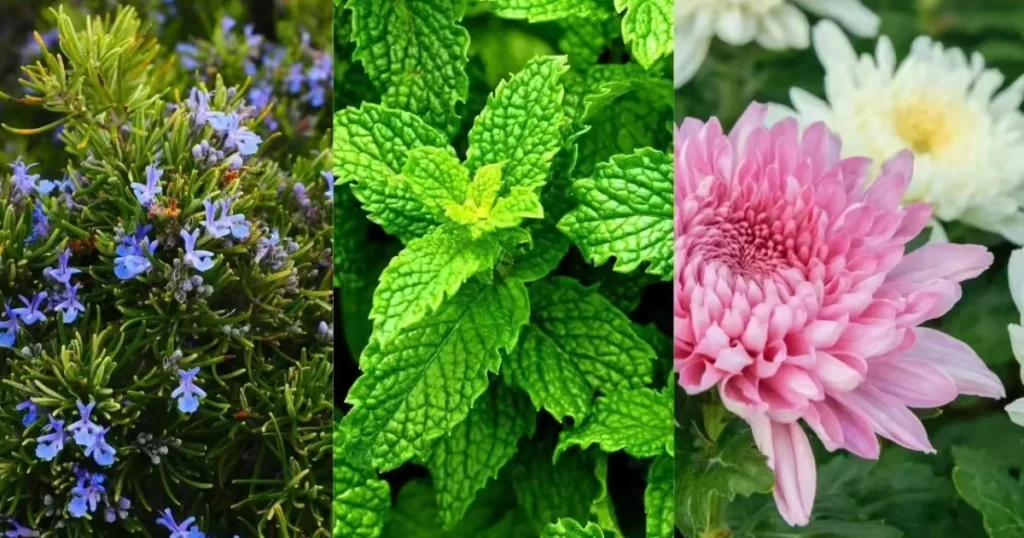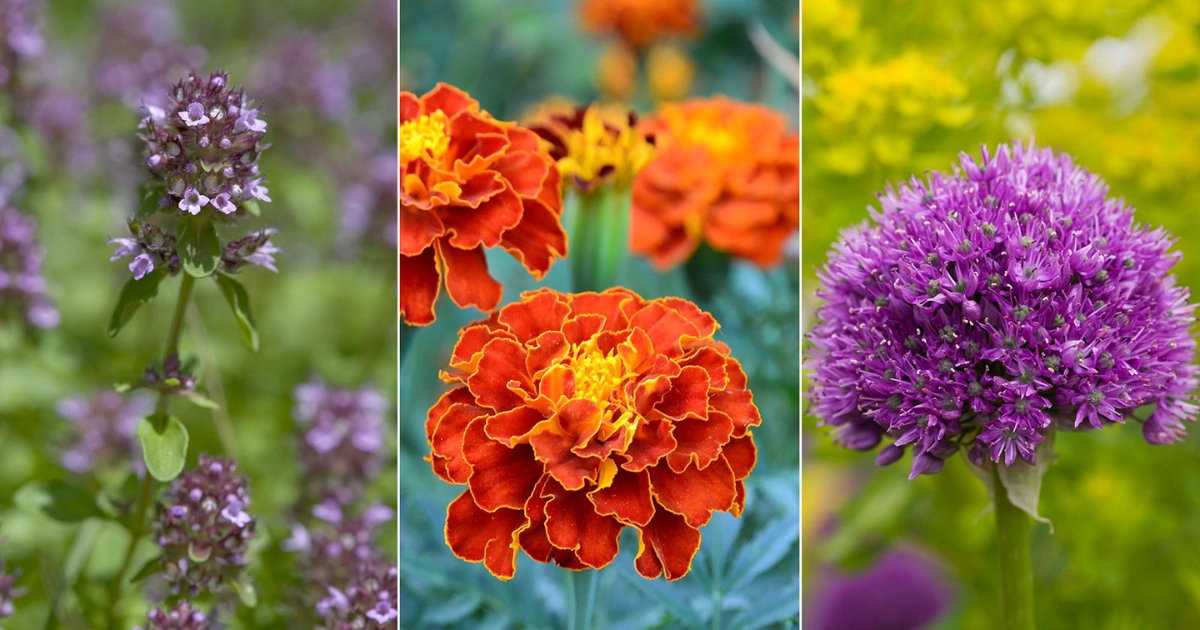Traditional pest control methods like chemical pesticides can be effective, but they also come with serious downsides. They can pollute the environment, harm beneficial insects, and even affect your health. Fortunately, nature offers its own alternatives.
Some plants naturally repel common pests thanks to their strong scents or chemical compounds. By strategically placing these plants in your vegetable garden or around your home, you can reduce pest problems and create a more sustainable, chemical-free garden ecosystem.
Here are 10 powerful insect-repelling plants that every gardener should know.

1. Basil – Repels Mosquitoes and Flies
Basil is a popular culinary herb, but it’s also an effective natural repellent for mosquitoes, whiteflies, and other flying insects. Its strong aroma deters unwanted pests while attracting pollinators like bees and butterflies.
Best placement: Near tomatoes, peppers, or in pots by doors and windows.
2. Mint – Fends Off Ants and Cockroaches
Mint, especially peppermint, has a sharp, clean scent that repels ants, aphids, cockroaches, and fleas. However, mint can be invasive, so it’s best to plant it in containers.
Tip: Place potted mint near entrances or in the corners of your garden beds.
3. Lavender – A Beautiful Mosquito Barrier
Lavender isn’t just soothing—it’s also a natural repellent for mosquitoes, moths, and fleas. It thrives in sunny spots and can double as an ornamental feature and pest control aid.
Use case: Plant along garden borders or near seating areas for both beauty and protection.
4. Thyme – Small Herb, Big Impact
Thyme may be small, but it packs a punch against pests. It effectively repels ants, flies, cabbage loopers, and beetles with its essential oils.
Garden tip: Try lemon thyme for extra potency and a pleasant citrus scent.
5. Garlic – Natural Defense Against Aphids
Garlic is a powerful natural pesticide. When planted in the garden, it deters aphids, ants, spider mites, and even fungal pathogens. It also boosts nearby plants’ immunity.
Planting idea: Scatter garlic cloves between vegetable rows or in flower beds.
6. Onion – Companion Plant Extraordinaire
Like garlic, onions release sulfur compounds that repel aphids, ants, and mites. They’re excellent companion plants for carrots, lettuce, and strawberries.
Bonus: They help improve overall plant resilience without chemicals.
7. Parsley – Gentle But Effective
Parsley isn’t just for garnishing your meals—it’s also a natural deterrent. It helps to repel cockroaches, flies, and ants while attracting beneficial insects like hoverflies.
Tip: Grow it between root vegetables or use as a border plant.
8. Rosemary – Deters Moths and Beetles
Rosemary emits a strong aroma that repels cabbage moths, carrot flies, and mosquitoes. It’s an ideal plant for dry, sunny areas and also adds flavor to your kitchen.
Use it: In raised beds, along pathways, or in pots near entryways.
9. Bay Laurel – Natural Cockroach Fighter
Bay leaves contain compounds that repel roaches, ants, and flies. You can plant bay laurel in pots or use dried leaves indoors to keep pantry pests away.
Practical use: Place dried bay leaves in kitchen cabinets and near pet food bowls.
10. Marigold (Calendula) – Aphid and Nematode Defender
Marigolds are not just decorative—they are excellent natural repellents for aphids, nematodes, whiteflies, and beetles. Their roots release chemicals that deter soil-dwelling pests.
Best strategy: Interplant marigolds throughout your vegetable garden for ongoing protection and color.
Why Use Insect-Repelling Plants?
Incorporating these plants into your garden design is more than just a pest control strategy—it’s a way to promote biodiversity, reduce chemical use, and support pollinators. These natural solutions are:
- Eco-friendly and sustainable
- Safe for children, pets, and edible crops
- Aesthetic and aromatic additions to your space
- Cost-effective and easy to grow
How to Maximize Their Effectiveness
- Mix and match: Combine several insect-repelling plants for broader protection.
- Plant near vulnerable crops: Use as companion plants for tomatoes, lettuces, cucumbers, and herbs.
- Use in pots: Many of these herbs thrive in containers, perfect for balconies or patios.
- Make homemade sprays: Use fresh or dried leaves (e.g., garlic or thyme) to make pest-repellent teas or decoctions.
Frequently Asked Questions
Can these plants completely eliminate pests?
No. While highly effective, they’re best used as part of an integrated pest management approach, alongside good gardening practices, crop rotation, and manual pest removal.
Do these plants attract beneficial insects?
Yes. Many (like lavender, parsley, and marigold) attract pollinators and predatory insects, which help control harmful pest populations naturally.
Can I grow these plants indoors?
Absolutely. Herbs like mint, basil, and thyme grow well in containers and help repel indoor pests like flies and mosquitoes.
How long before I see results?
You may notice reduced pest activity within a few weeks. Consistent planting and proper spacing help strengthen their repelling effect over time.
Can I use dried leaves from these plants indoors?
Yes. Dried bay leaves, lavender, rosemary, and mint can be placed in drawers, cupboards, or sachets to repel pantry pests and moths.
Related Articles from secretsofthegreengarden.com
Want to go deeper into natural gardening solutions? Try these:
- How to Create a Pest-Resistant Garden Without Chemicals
- Best Plant Combinations to Naturally Deter Insects
- DIY Herbal Sprays for Organic Pest Control
Recommended External Resources
- Terre Vivante – Organic Gardening and Natural Pest Solutions
- RHS – Gardening for Biodiversity
- INRAE – Integrated Pest Management
Main keyword: insect-repelling plants for garden
LSI/NLP keywords used: natural pest control, pest-resistant garden plants, organic insect repellents, companion planting, eco-friendly gardening, herbs that repel bugs, mosquito repellent plants, natural pest deterrents
Internal link suggestions from secretsofthegreengarden.com:
- How to Create a Pest-Resistant Garden Without Chemicals
- Best Plant Combinations to Naturally Deter Insects
- DIY Herbal Sprays for Organic Pest Control
External link suggestions with anchor text: - Terre Vivante – Organic Gardening and Natural Pest Solutions
- RHS – Gardening for Biodiversity
- INRAE – Integrated Pest Management
Let me know if you’d like this turned into an infographic, social media carousel, or downloadable printable version.


Cappadocia luxury tour Daniel T. ★★☆☆☆ Balloon flight cancelled due to weather (no refund). Alternative wine tasting felt rushed. Clearer cancellation terms needed. https://kacak.stck.me/post/1124195/Experience-Culture-with-Cappadocia-Tours-2025
Cappadocia sunrise balloon flight Isabella R. ★★★★★ Gluten-free travelers: Special menus at every meal! Even GF simit at breakfast. Felt truly cared for. https://www.budgettoursturkey.com/12-days-eastern-anatolia-tour.html
Продолжение kraken37
Cappadocia Cave hotels Samuel R. ★★★☆☆ Green Tour’s Ihlara Valley hike is moderate difficulty (not easy). Seniors in our group struggled. Better difficulty labeling needed. https://murtistour.com/istanbul-culture-and-history-tours.html
Cappadocia romantic getaway Olivia J. ★★★★★ For solo female travelers: Felt completely safe! Women-only hiking group with expert guide Fatma was empowering. https://www.leenkup.com/read-blog/44370
Cappadocia tours from Istanbul Noah S. ★★☆☆☆ Luxury cave hotel pool was under renovation (not mentioned at booking). Disappointed after 12hr flight. https://leicestercityfansclub.com/read-blog/11939
Goreme open air museum Chloe P. ★★★★★ Photography tour delivered! Our guide took us to hidden valleys before sunrise. My Instagram has never had more engagement! https://alumeet.com/read-blog/27586
зайти на сайт kra36 at
Cappadocia romantic getaway Olivia J. ★★★★★ For solo female travelers: Felt completely safe! Women-only hiking group with expert guide Fatma was empowering. https://camlive.ovh/read-blog/18779
нажмите https://kra36at.at/
взгляните на сайте здесь Kra36.at
Scoprite Milano con Vera Love
Having read this I thought it was very informative. I appreciate you taking the time and effort to put this article together. I once again find myself spending way to much time both reading and commenting. But so what, it was still worth it!
I’ve learn a few excellent stuff here. Definitely value bookmarking for revisiting. I wonder how much effort you put to make this kind of fantastic informative website.
Way cool, some valid points! I appreciate you making this article available, the rest of the site is also high quality. Have a fun.
I like this weblog its a master peace ! Glad I noticed this on google .
Hello my family member! I want to say that this article is awesome, nice written and come with approximately all vital infos. I would like to see more posts like this .
https://t.me/site_official_1win/247
I have not checked in here for a while because I thought it was getting boring, but the last few posts are great quality so I guess I will add you back to my daily bloglist. You deserve it my friend 🙂
برای دوستانی که به دنبال یک راهکار مطمئن برای وریفای حساب در بروکرهای فارکس هستند، پیشنهاد میکنم خدمات شوپی را بررسی کنند. این مجموعه به صورت تخصصی، وریفای قانونی حساب های فارکس را با مدارکی ارائه میدهد که کاملاً معتبر بوده و به نام خودتان صادر میشود. این روش دائمی است و ریسک بلاک شدن حساب شما را به صفر میرساند. کیفیت و پشتیبانیشان واقعاً عالی است.
https://t.me/iGaming_live/4872